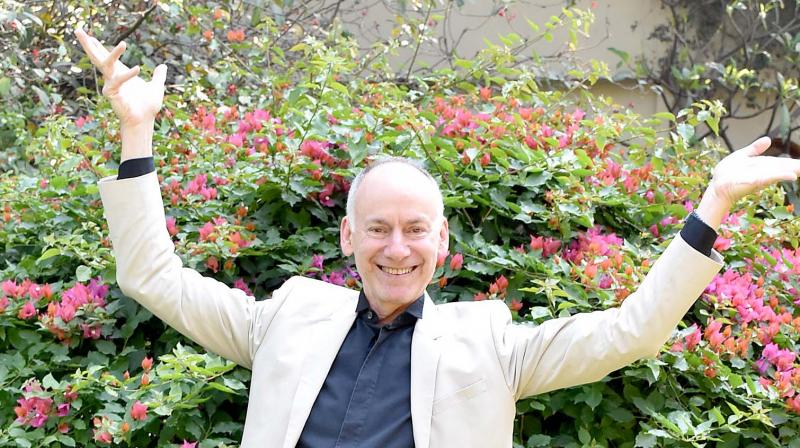Dance weaves a tale of power
Jonathan Hollander, founder, director and lead dancer of Shakti, an internationally acclaimed production, and his dance troupe were in the city.

The music will haunt you. Rajan and Sajan Mishra's rendition of Raag Durga strikes a clear path to the audience's soul as the dancers enter, their movements, slow, measured, reverent. This is Jonathan Hollander's Shakti – Return to the Source, the production that premiered back in 2016 as The Durga Project. “And it was the Raag,” says Jonathan, that gave rise to the production itself.
In 1976, Jonathan founded the Battery Dance Company in New York, which embarked on a mammoth journey made up of over 75 productions, including those performed in conflict zones around the world. They also founded the Battery Dance Festival, one of the largest in the United States. After a trip to India in 1992 as a Fulbright scholar, Jonathan returned home with a casette that had been in his keeping by an Indian dancer, Rajan Prajapati. Months later in New York, he heard it for the first time and seeds of The Durga Project were sown. “It is the basis of this production – the notes, the voices of Rajan and Sajan Mishra. It's this soulful expression that comes from so deep inside the body – how can we extend, expand and breathe through the music.”
On Saturday morning, Jonathan and his company of dancers are in the middle of a light moment, all obligingly striking a pose (or three) for the group of photographers milling around on the lawns of The Oberoi, Bengaluru. Viveshwar Raj Singh, the General Manager, and Vice President, is present as well – it was the word of a friend from Mumbai, that first introduced him to Jonathan Hollander and the Battery Dance Company. Jonathan Hollander is also the director and lead dancer of Shakti. “They were very progressive and contemporary – they have also taken an Indian dance form all across the world. It would have been a shame not to do something for someone propagating an art form that has its roots in India. It's great to have them here, this has been in the pipeline for a month,”states Viveshwar. Sure enough, it promises to be a packed three days – Jonathan and his dancers have just returned from a cultural exploration to Hassan and will conduct a number of workshops with NGOs across the city, aside from their performance on Saturday night.
Away from the glare of the cameras, Jonathan Hollander is the epitome of gravity, with an unmistakable aura of transcendence. He talks at length of Indian music, dance and poetry, describing weeping with his daughter on his shoulder as he read a short story by Rabindranath Tagore.
Jonathan has worked with dancers from across the world, tied up with a number of causes from rehabilitating immigrants to the voice of women. And through it all, he carries with it a certain sensibility, an unwavering dedication to his art.
This, he says, he learned in India, when he first arrived in the country at the age of 16. “I had a wonderful teacher who taught me how to play the sitar. I was used to the piano at the time and he told me that if I wanted to play the sitar, I would have to develop calluses on my fingers. You give up the beauty of your fingers in order to create the beauty of the instrument. You sacrifice something for something much enlightened and higher. For a 16 year old from suburban Washington, it was a life changing moment.”
He shunned the search for money and power, dedicating himself to his art and preparing for the many challenges it would pose. During his latter trips to India, he worked his way through a society that looked upon art as little more than a hobby. “Even so, I wanted to pursue the arts, the creation and learn how to do that. I've had to learn marketing, accounting and law – the pillars of an arts organisation. That's a sacrifice – that's not what I want to be thinking about everyday. But if I take my eye off the ball, things will fall apart. It's my balance.”
The Durga Project was so well-received in the United States, with two Consul Generals of India, in Houston and New York, falling in love with it. Audiences were blown away in equal measure – 'We haven't seen anything like this before' became something of a refrain. And it only cemented Jonathan's desire to bring the show to India. It was renamed Shakti - A Return to the Source for the trip ,for two reasons. “There is the danger of people coming to the theatre looking for the Goddess and wondering where her story is. They might find her hiding but I don't want them to say, 'There she is!’ Hints are alright, but this show is about the power of women.” It is Jonathan's definitive show of solidarity to the rising feminist movement, adding his unique voice, one he believes only dance can do with its subtle reinforcement of societal notions. “This production is about the power of women. I have two daughters and I worship them. Also, in traditional dance, the man is the powerful master but we all know that it's the women who hold it together. Their feminine charm and beauty hold great power. Just look. It's always there. It's always there,” Jonathan concludes.

